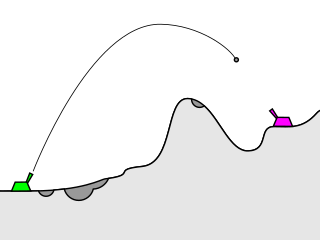Related Research Articles

The Sipuncula or Sipunculida is a class containing about 162 species of unsegmented marine annelid worms. The name Sipuncula is from the genus name Sipunculus, and comes from the Latin siphunculus meaning a "small tube".
Klez is a computer worm that propagates via e-mail. It first appeared in October 2001. A number of variants of the worm exist.

This timeline of computer viruses and worms presents a chronological timeline of noteworthy computer viruses, computer worms, Trojan horses, similar malware, related research and events.

Blaster was a computer worm that spread on computers running operating systems Windows XP and Windows 2000 during August 2003.
mydoom also known as, my.doom, W32.MyDoom@mm, Novarg, Mimail.R, Shimgapi, W32/Mydoom@MM, WORM_MYDOOM, Win32.Mydoom is a computer worm affecting Microsoft Windows. It was first sighted on January 26, 2004. It became the fastest-spreading e-mail worm ever, exceeding previous records set by the Sobig worm and ILOVEYOU, a record which as of 2022 has yet to be surpassed.
The compilation of a unified list of computer viruses is made difficult because of naming. To aid the fight against computer viruses and other types of malicious software, many security advisory organizations and developers of anti-virus software compile and publish lists of viruses. When a new virus appears, the rush begins to identify and understand it as well as develop appropriate counter-measures to stop its propagation. Along the way, a name is attached to the virus. As the developers of anti-virus software compete partly based on how quickly they react to the new threat, they usually study and name the viruses independently. By the time the virus is identified, many names denote the same virus.
Bagle was a mass-mailing computer worm affecting Microsoft Windows. The first strain, Bagle.A, did not propagate widely. A second variant, Bagle.B, was considerably more virulent.

In computing, a zombie is a computer connected to the Internet that has been compromised by a hacker via a computer virus, computer worm, or trojan horse program and can be used to perform malicious tasks under the remote direction of the hacker. Zombie computers often coordinate together in a botnet controlled by the hacker, and are used for activities such as spreading e-mail spam and launching distributed denial-of-service attacks against web servers. Most victims are unaware that their computers have become zombies. The concept is similar to the zombie of Haitian Voodoo folklore, which refers to a corpse resurrected by a sorcerer via magic and enslaved to the sorcerer's commands, having no free will of its own. A coordinated DDoS attack by multiple botnet machines also resembles a "zombie horde attack", as depicted in fictional zombie films.
Sasser is a computer worm that affects computers running vulnerable versions of the Microsoft operating systems Windows XP and Windows 2000. Sasser spreads by exploiting the system through a vulnerable port. Thus it is particularly virulent in that it can spread without user intervention, but it is also easily stopped by a properly configured firewall or by downloading system updates from Windows Update. The specific hole Sasser exploits is documented by Microsoft in its MS04-011 bulletin, for which a patch had been released seventeen days earlier. The most characteristic experience of the worm is the shutdown timer that appears due to the worm crashing LSASS.
Netsky is a prolific family of computer worms which affect Microsoft Windows operating systems. The first variant appeared on Monday, February 16, 2004. The "B" variant was the first family member to find its way into mass distribution. It appeared on Wednesday, February 18, 2004. 18-year-old Sven Jaschan of Germany confessed to having written these, and other worms, such as Sasser.

Dracunculiasis, also called Guinea-worm disease, is a parasitic infection by the Guinea worm, Dracunculus medinensis. A person becomes infected by drinking water containing water fleas infected with guinea worm larvae. The worms penetrate the digestive tract and escape into the body. Around a year later, the adult worm migrates to an exit site – usually a lower limb – and induces an intensely painful blister on the skin. The blister eventually bursts to form an intensely painful open wound, from which the worm slowly crawls over several weeks. The wound remains painful throughout the worm's emergence, disabling the infected person for the three to ten weeks it takes the worm to emerge. During this time, the open wound can become infected with bacteria, leading to death in around 1% of cases.
ILOVEYOU, sometimes referred to as Love Bug or Love Letter for you, is a computer worm that infected over ten million Windows personal computers on and after 5 May 2000. It started spreading as an email message with the subject line "ILOVEYOU" and the attachment "LOVE-LETTER-FOR-YOU.TXT.vbs." At the time, Windows computers often hid the latter file extension by default because it is an extension for a file type that Windows knows, leading unwitting users to think it was a normal text file. Opening the attachment activates the Visual Basic script. First, the worm inflicts damage on the local machine, overwriting random files, then, it copies itself to all addresses in the Windows Address Book used by Microsoft Outlook, allowing it to spread much faster than any other previous email worm.
Zotob is a computer worm which exploits security vulnerabilities in Microsoft operating systems like Windows 2000, including the MS05-039 plug-and-play vulnerability. This worm has been known to spread on Microsoft-ds or TCP port 445.

Dracunculus medinensis, or Guinea worm, is a nematode that causes dracunculiasis, also known as guinea worm disease. The disease is caused by the female which, at up to 80 centimetres in length, is among the longest nematodes infecting humans. In contrast, the longest recorded male Guinea worm is only 4 cm.

Artillery games are two or three-player video games involving tanks trying to destroy each other. The core mechanics of the gameplay is almost always to aim at the opponent(s) following a ballistic trajectory. Artillery games are among the earliest computer games developed; the theme of such games is an extension of the original uses of computer themselves, which were once used to calculate the trajectories of rockets and other related military-based calculations. Artillery games have been described as a type of "shooting game", though they are more often classified as a type of strategy video game.
Stration is a family of computer worms that can affect computers running Microsoft Windows, disabling security features and propagating itself to other computers via e-mail attachments. This family of worms is unusual in that new variants are being produced at an unprecedented rate, estimated to be up to one every 30 minutes at its peak, and downloaded from remote servers by infected machines to speed propagation. This makes detection and removal a particular challenge for anti-virus software vendors, because new signature files for each variant need to be issued to allow their software to detect them.
Koobface is a network worm that attacks Microsoft Windows, Mac OS X, and Linux platforms. This worm originally targeted users of networking websites like Facebook, Skype, Yahoo Messenger, and email websites such as GMail, Yahoo Mail, and AOL Mail. It also targets other networking websites, such as MySpace, Twitter, and it can infect other devices on the same local network. Technical support scammers also fraudulently claim to their intended victims that they have a Koobface infection on their computer by using fake popups and using built-in Windows programs.

Conficker, also known as Downup, Downadup and Kido, is a computer worm targeting the Microsoft Windows operating system that was first detected in November 2008. It uses flaws in Windows OS software and dictionary attacks on administrator passwords to propagate while forming a botnet, and has been unusually difficult to counter because of its combined use of many advanced malware techniques. The Conficker worm infected millions of computers including government, business and home computers in over 190 countries, making it the largest known computer worm infection since the 2003 Welchia.
Slenfbot is the classification for a family of malicious software (malware), which infects files on Microsoft Windows systems. Slenfbot was first discovered in 2007 and, since then, numerous variants have followed; each with slightly different characteristics and new additions to the worm's payload, such as the ability to provide the attacker with unauthorized access to the compromised host. Slenfbot primarily spreads by luring users to follow links to websites, which contain a malicious payload. Slenfbot propagates via instant messaging applications, removable drives and/or the local network via network shares. The code for Slenfbot appears to be closely managed, which may provide attribution to a single group and/or indicate that a large portion of the code is shared amongst multiple groups. The inclusion of other malware families and variants as well as its own continuous evolution, makes Slenfbot a highly effective downloader with a propensity to cause even more damage to compromised systems.

Parascaris equorum is a species of ascarid that is the equine roundworm. Amongst horse owners, the parasites are colloquially called "Ascarids". This is a host-specific helminth intestinal parasite that can infect horses, donkeys, and zebras. Horses up to six months of age are the most susceptible to infection. After this time, infection rates begin to decline and is extremely uncommon in horses over twelve months of age. It cannot infect humans or other animals. It is yellow-white in color, and females can become as large as 15 inches (38 cm) in length. Found worldwide, P. equorum is one of the most difficult equine parasites to kill, requiring larger doses of more powerful anthelmintic medications than are needed for other equine parasites.
References
- ↑ "Email-Worm:W32/Mimail.I". F-Secure . Retrieved 17 November 2022.